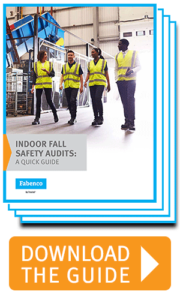
OSHA’s 2,100 compliance officers oversee more than eight million worksites in the country. And in 2019 they conducted 33,401 inspections of those sites, many of which were unannounced or “unprogrammed”, as they say. Needless to say, it can be stressful for owners, managers, and staff when an inspector shows up on the job site. But if you’re prepared for an inspection, you have nothing to worry about – as long as you’re taking safety precautions as a matter of policy and using appropriate OSHA fall protection equipment like safety gates, guardrails, safety harnesses and more.
Surprise Inspections vs. Scheduled Inspections
OSHA compliance officers can’t visit every worksite every year, so they focus on the ones most likely to be in violation of OSHA fall protection and other standards. Top priority goes to workplaces and situations that present an imminent danger, while the next priority is given to workplaces that have recently had incidents involving serious injury. Worker complaints about safety in the workplace are also taken seriously.
If you’ve failed an inspection, a follow-up inspection may be scheduled so the inspector can ensure you’ve corrected the violations. You may also get a scheduled inspection in these situations:
- Imminent Danger: OSHA may contact you in hopes of getting you to fix the problem immediately before anyone gets hurt.
- Scheduling: If for some reason the inspection can’t take place during normal business hours, OSHA may make special arrangements with you.
- Availability of Managers and Representatives: If OSHA isn’t sure the worker representatives and managers will be onsite at the time of the inspection, they may schedule a time to ensure these people are available.
- Other: In some cases, OSHA may believe a scheduled visit will allow for a more thorough inspection.
Preparing for a scheduled inspection includes all the points we’ll discuss below, in addition to ensuring you’ve fixed any issues discovered during a prior inspection. If you know you have an inspection coming, you should do a self-audit to ensure you’re up to the standards. If not, make permanent changes to ensure compliance.
How to Prepare for an Inspection
The best preparation is a commitment to safety. If you’re using OSHA-compliant safety gates, a safety harness and lanyard, and other equipment, for example, training your employees thoroughly, documenting incidents, procedures, and protocols, and staying focused on safety on a daily basis, you’re already prepared to meet the compliance officer.
Here are a few more ways to help your inspection go smoothly:
Designate Representatives
An employee representative and a safety manager or the owner are allowed to be present during the opening conference and throughout the inspection. You should decide in advance who these people are so they are ready to go if an inspector shows up. There should also be an alternate who is ready to go in case the others happen to be offsite when the inspection occurs.
Explain to your employees that if an inspection ever occurs, they can simply continue work as normal. The OSHA officer aims to limit disruptions. They should be aware they may also be interviewed by the officer.
Know What to Expect
Inspections follow a predictable pattern. When the compliance officer arrives, they will show you their credentials. If you need to make a call to get your safety manager on-site, it’s reasonable to ask the officer to wait while you do that. You have the right to deny permission for an inspection, but it probably won’t work out in your favor. OSHA can and will get a warrant, and by denying permission it will seem as though you have something to hide.
During the opening conference, the officer will explain the reason for and scope of the inspection. Take notes, and don’t be afraid to ask for more time to do so if needed. You may be asked to show safety documents and records. Keep careful documentation of your health and safety policies, emergency procedures, training history, and incident reports.
Your safety manager and worker representative will guide the officer through your work site. If the officer points out a small violation that can be easily corrected, you can take steps at that moment to do so, which helps build good faith. After this “walkaround,” there will be a closing conference.
Remember: the officer is hoping not to find any violations because that would mean you maintain a safe, compliant workplace. It’s not an “us against them” situation. Both you and the compliance officer are focused on ensuring the safest possible working conditions for your employees.
Use OSHA-Compliant Safety Equipment
While there are many OSHA standards covering a variety of workplaces and scenarios, “Falls are among the most common causes of serious work-related injuries .” From choosing the right safety harness and lanyard to thoroughly training your employees, getting your fall protection in order will go a long way in preparing for an OSHA inspection—and keeping your workers safe.
There are fall safety standards specific to the construction industry as well as general fall safety standards that apply to all industries. An industrial gate, for example, may be required to restrict access and protect against leading-edge falls in a variety of workplace situations.
Choose an OSHA-compliant industrial gate, safety harness and lanyard, and any other equipment you need to comply with OSHA fall protection guidelines. You don’t have to worry whether or not your safety gates will pass an inspection if you purchase an industrial gate, or any other fall protection devices, from a company that only sells OSHA-compliant equipment.
Preparing for an OSHA inspection is a matter of compliance—which is essential all year, every year, even if your workplace never gets inspected. If safety is already built into your company culture, you likely have nothing to worry about during an inspection.








